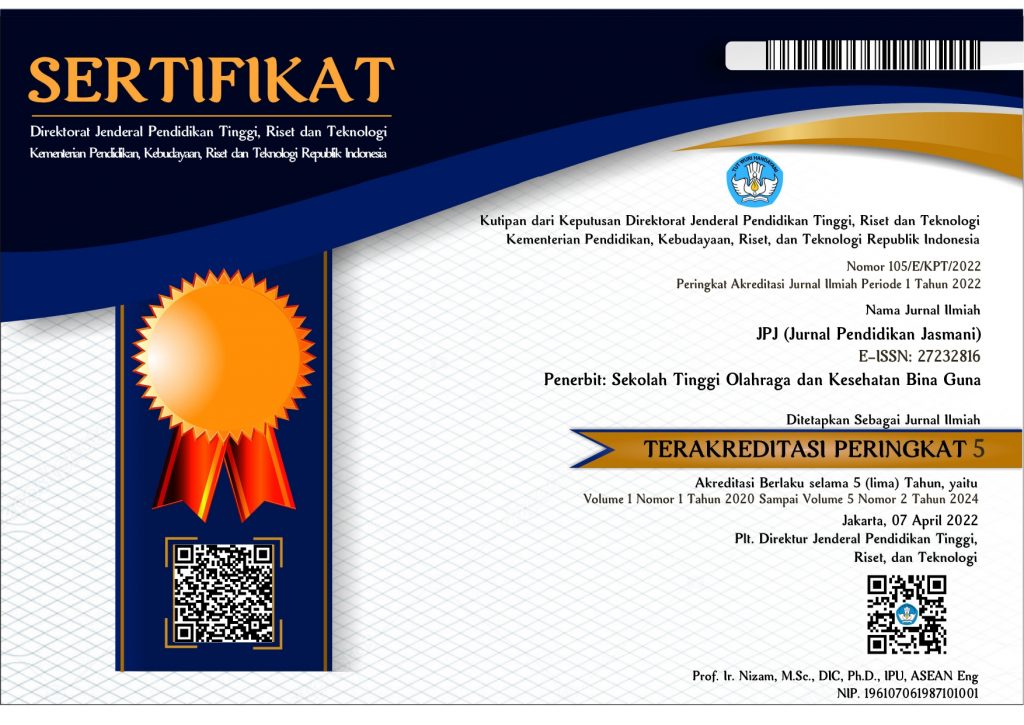The Relationship Between Body Mass Index (BMI) And Physical Fitness Of Students At SD N 1 Labuhan Ratu Bandar Lampung Post-Pandemic Covid-19
Abstract
This study aims to determine the magnitude of the relationship between body mass index (BMI) and the physical fitness of students of SD N 1 Labuhan Ratu, Bandar Lampung City. This research uses a survey method with a correlational quantitative approach. The population used is class V with a total of 40 students. The sampling technique used total sampling consisting of 23 sons and 17 daughters. Body mass index (BMI) instruments, namely digital scales and height measuring devices, then physical fitness used the TKJI test for ages 10-12 years. Data analysis used the product moment correlation test. The results of this study indicate that there is a relationship between body mass index (BMI) and the physical fitness of SD N 1 Labuhan Ratu students in Bandar Lampung city which can be seen from the interpretation criteria for the correlation coefficient r, namely the value rx.y = 0.768 is strong for boys and rx.y = 0.562 is for women. Moderate results for women because their level of physical fitness is low and for men their level of physical fitness is strong. These results are because gender is a factor that affects physical fitness. So the conclusion is that there is a relationship between body mass index (BMI) and physical fitness for both boys and girls, but for male students the relationship is stronger while for female students the relationship is moderate.
References
Arifin. Zainul. (2018). Pengaruh Latihan Senam Kebugaran Jasmani (SKJ) Terhadap Tingkat Kebugaran Siswa Kelas V Di MIN Donomulyo Kabupaten Malang. Al-Mudarris Journal Of Education. 1 (1), 22-29. http://dx.doi.org/10.32478/al-mudarris.v1i1.96.
Darmawan. Ibnu. (2017). Upaya Meningkatkan Kebugaran Jasmani Siswa Melalui Penjas. Jurnal Inspirasi Pendidikan. 7 (2),143-154. https://doi.org/10.21067/jip.v7i2.1700.
Dhara. S & Chatterjee. K. (2015). A Study of VO2 Max in Relation With Body Mass Index (BMI) of Physical Education Student. Research Journal of Physical Education Science. 3 (6), 2320-9011.
Lubis. Sulastri. & Afriwardi. (2017). Hubungan Indeks Massa Tubuh Dengan ketahanan Kardiorespirasi, Kekuatan Dan Ketahanan Otot Dan Fleksibilitas pada Mahasiswa Laki-Laki Jurusan Pendidikan Dokter Universitas Andalas Angkatan 2013. Jurnal Kesehatan Andalas. 4 (1), 142-150.
Mahfud. Imam., Agus. G., & Eko. Bagus. F. (2020). Analisis IMT (Indeks Massa Tubuh) Atlet UKM Sepakbola Universitas Teknokrat Indonesia. Journal of Sport Athleticism in Teaching and Recreation on Interdisciplinary Analysis. 3 (1), 9 – 13.
Nugraha. Bayu. (2015). Pendidikan Jasmani Olahraga Usia Dini. Jurnal Pendidikan Anak. 4 (1), 557-564.
Pratiwi. N. M. I & Muliarta. I. M. (2017). Hubungan Tingkat Kesegaran Jasmani Dan Indeks Massa Tubuh Pada Siswa Usia 9-12 Tahun Di SD Negeri 4 Sumerta Tahun 2014. E-Jurnal Medika. 6 (9), 18-21.
Situmorang. M. (2015). Penentuan Indeks Massa Tubuh (IMT) Melalui Pengukuran Berat Dan Tinggi Badan Berbasis Mikrokontroler AT89S51 dan PC. Jurnal Teori dan Aplikasi Fisika. 3 (2), 102-110.
Utama. A. M. B. (2011). Pembentukan Karakter Anak Melalui Aktivitas Bermain Dalam Pendidikan Jasmani. Jurnal Pendidikan Jasmani Indonesia. 8(1), 1-9. https://doi.org/10.21831/jpji.v8i1.3477.
Copyright (c) 2023 Jurnal Pendidikan Jasmani (JPJ)

This work is licensed under a Creative Commons Attribution-ShareAlike 4.0 International License.










